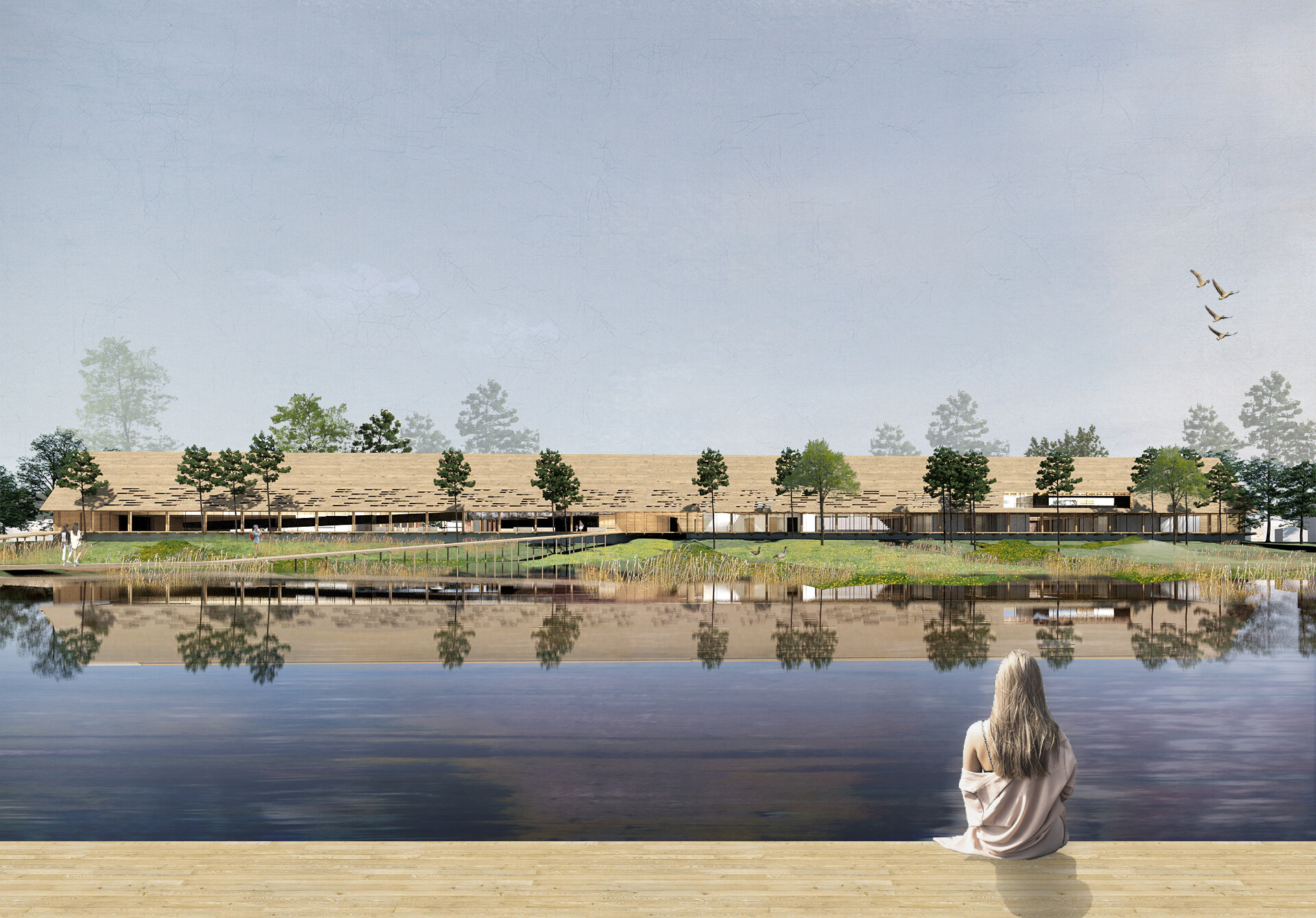
NATIONAL LOG MUSEUM
YEAR 2020
TYPE museum, wetland centre, research & education facilities, shop
SIZE 5000 m²
CLIENT Museene i Akershus
LOCATION Fetsund, Norway
Concept
The site overlaps three different zeitgeists - the timeless wetlands, the historical timber floating, and the need to disseminate to cultural heritage of the place. This entry tries to capture the commonality of the three - the nature in motion and mankind’s attempts to tame it.
The architectural experience takes the visitors through a journey of experiences, moods and motions without disturbing the nature. The long and narrow configuration gives the building many desired traits. For instance, all of the users/spaces will have access to natural ventilation and light, and most of them will a direct connection to the lake. The elongated pitched roof is a homage to the traditional boathouses and wood mills of the timber industry.
This entry also investigates the duality of a static and mobile museum, and how the latter can be part of a larger place-making strategy.
The connection between land and water (cross) are disconnected by visual and physical barriers of trees and wetlands. A closer inspection of the one open field near the water, shows a sightline between two historical references of the timber industry (circle).
The volume creates a natural connection between land and water. As the length of the museum will be parallel with the water, also means that the different users of the building will have contact with water. Closer inspection (circle), shows that the historical references most likely crossed.
The historical references are reconnected creating a safe passage between land and water, and not least without disturbing the nature. One of the boathouses has the ability to break off and travel the lake.
Placemaking Strategy
There exists a catamaran for the sole purpose of charters and sightseeing on the Øyeren river. The placemaking strategy is for this catamaran to pull the one mobile boathouse, so it can go from one destination to the next disseminating knowledge about the wetlands and the timber industry. This can both benefit the revenues for both the catamaran (which is currently in decline), and boost the marketing of the national log museum.
The brief points that the establishing of the museum is to also serve placemaking purposes, yet the site is hidden the back of a suburban neighbourhood in the already remote Fetsund. The idea of a travelling boathouse enables the museum to be present several places throughout the year. The boathouse will be used to strategically promote established and well known places, and other forgotten but hidden gems in the area.
The source of inspiration for a “travelling boathouse” dates back to 1800-1820 where different vessels of various sorts and sizes covered the Pearl River in Guangzhou, China (see the image series below curated by the Victoria & Albert Museum).
The vast and rich destinations that the travelling boathouse can visit and disseminate its knowledge. The established and potential docks on the Nordre Øyeren Lake.
The proposed site (3) is a part of a larger open-air museum scheme. Investigating its formation also reveals an alternative water route that can alleviate the local neighbourhoods on land from traffic:
Fetsund Booms - the last intact part of the historical timber industry.
Visitor Centre Wetlands - the existing centre.
National Log Museum - the new site and final outreach for travellers on water, before setting out for Nordre Øyeren nature reserve.
A passenger boat. Credit: Victoria & Albert Museum collection.
A theatrical troupe’s boat performing in different towns and counties. Credit: Victoria & Albert Museum collection.
A duck boat, specially designed to function both as the home and transport vessel. Credit: Victoria & Albert Museum collection.
A emperor’s boat. Credit: Victoria & Albert Museum collection.
A floating grocery, where food such as pork, rice and fruit was sold. Credit: Victoria & Albert Museum collection.
A prostitute’s boat. It remained stationary on the river, so the clients were ferried to it. Credit: Victoria & Albert Museum collection.
The Exhibition Journey
The exhibition spaces are to capture the temporary nature of the place, landscape and industry. The same way as the timber floats on the Glomma river or how the geese migrate, the exhibition itself is conceived as a journey through the terrain rather than something fixed or static.
Upon arrival in the upper parts of the lobby/ticket area, de visitors are invited to cross the bridge to the exhibition area. From here the journey takes you on a descending ramp that strung from the ceiling. On this ramp, one finds oneself surrounded by timber logs with window slabs that illuminates the room. These slabs are to recreate the beams of light in the forests of Upper Glomma in Trøndelag - the source to the river and timber harvesting that defines Øyeren. In many ways, this ramp symbolizes this journey. The ramp itself has some natural interruptions of flow, to give room for contemplation when in the exhibition. It is not until the visitors has completed the journey on the ramp that the panoramic view on the lower level reveals itself.
The exhibition spaces are generous in terms of its high ceiling height and large floorpane, which again opens for a greater flexibility in terms of what objects and medium one chooses to exhibit.
The entire room under the long and narrow pitched roof with the infinite exposed beams and stacking does not only convey the art of carpentry but is also symbolic of the timber floating industry. To be precise, the dramatic floating years 1916-1917 when 14. 818, 467 logs flowed through the booms of Fetsund.
The Dramatic Floating Years 1916 - 1917. Credit: Anno/Norsk Skogmuseum.
The Glomma Cooperative Timber Floating Association, 1955. A branding system for how the logs were sold/bought across a vast regional network as they were all shipped down the same Glomma river. These same carvings has been used in the exterior doors in the design.






















